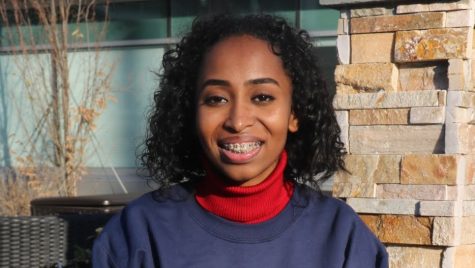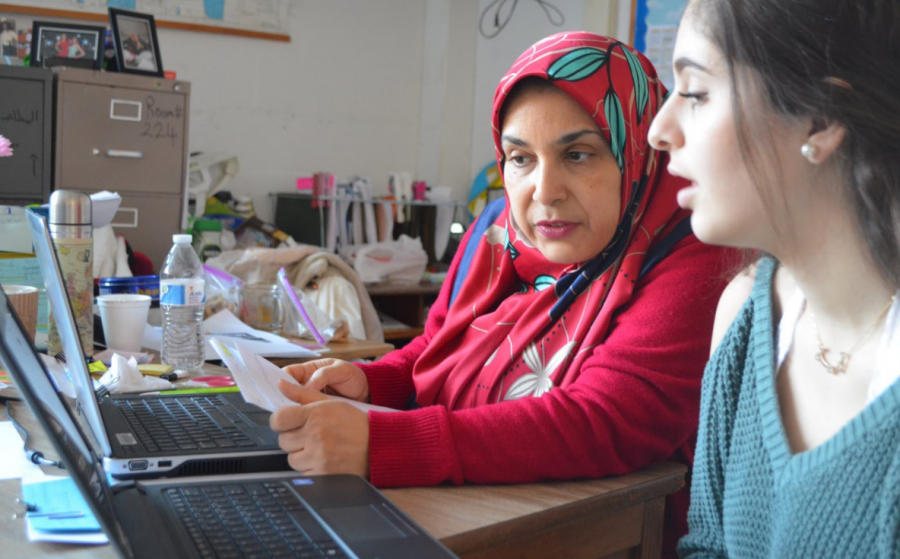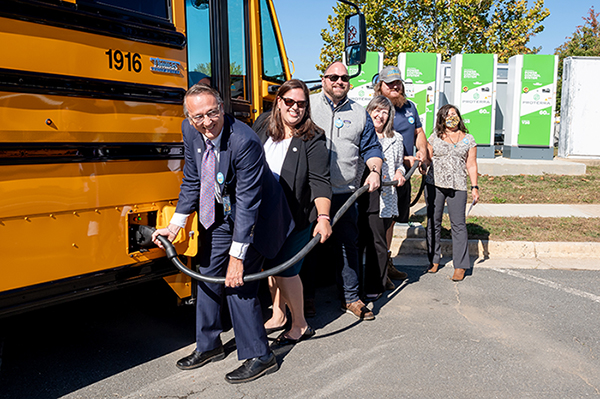FCPS strives to diversify its teacher workforce
Arabic teacher Ola Layaly connects with her students because of her ability to immerse her students in shared traditions, culture and background to the classroom.
AHS prides itself on being recognized for its richly diverse student body with students deriving from over 80 countries and speaking more than 40 languages.
As students go about their day, they are not the least bit alarmed at the dozens of languages heard in the hallway, the wide array of cultural/ethnic clubs, or the variety of complexions they walk past. What surprises them is that their teachers are overwhelmingly the opposite: mostly caucasian.
During the 2016-2017 school year, approximately 82 percent of Fairfax County teachers were white while 7.3 percent were black, 4.9 percent were Asian, 4.2 percent were Hispanic or Latino and 2 percent were multiracial.
Yet, Fairfax’s student population in the same year reflects a stark difference. 39.3 percent of Fairfax students were white, 25.4 percent were Hispanic or Latino, 19.5 percent were Asian, 10.1 percent were black, 5.3 percent were multiracial and the county is still becoming increasingly diverse.
Many of the teachers are diverse in age, political views, languages and other factors. AHS’ faculty members are hired for various reasons beyond race that make them qualified for their jobs.
Teachers can be hired in multiple ways. They can either turn in their resume directly to FCPS, email their resume to a division chair or use personal connections within a school.
“We want someone who appreciates and embraces diversity,” Principal Tim Thomas said. “Has a positive, growth mindset, collaborative, understands the value of teamwork, understands the value of communicating with families, loves working in an educational setting opportunities where we have adults in the building that look like and talk like our students is among the top priorities when it comes to hiring practices.”
There is no denying the positive effects for having more racially diverse teachers. Teachers of color provide positive role models and dispel negative stereotypes. Putting minority teachers before students help to create a more positive perception for students of color. They become an example for students to follow. Also, a more diverse teacher workforce can also supplement training in the culturally sensitive teaching practices most effective with today’s student populations.
Some students feel that as long as the teacher provides them with the correct information, it does not matter what race the teacher is.
“The race of our teachers should bear no consequence so long as they teach us what is needed to pass the tests as well as understand the material,” senior Zea Bonanno said.
However, the Department of Education in its 2016 report,“The State of Racial Diversity in the Educator Workforce,” suggests that teachers of color are more likely to have higher expectations of students of color (as measured by higher numbers of referrals to gifted programs). They can confront issues of racism, serve as advocates and cultural brokers, and develop more trusting relationships with students. This is particularly true with those whom they share a cultural background.
Educators like Arabic teacher Ola Layaly pride themselves on the fact they can further bond with students through shared language, culture, and heritage.
“I try to give students a holistic understanding of Arab culture because I have many kids who do not speak Arabic at home,” Layaly said. “This why I make sure the class is not just language class, but an immersion of Arab culture.”
Layaly’s classroom environment has been well-received among students who often give high praise about the unique classroom experience.
“[She] makes the class feel like home by sharing stories about our shared experiences or just making us tea.” senior Michelle Akl said. “She gives us advice and knows each student and their parents personally which is why it’s like a safe space for us.”
Superintendent Scott Brabrand has promised to change recruitment tactics in the staff so that it would more accurately reflect the county’s student makeup. One plan that he has looked at is recruiting the younger teachers of color and connecting them to their diverse networks at their colleges and universities. Brabrand cited the strong Middle Eastern community in Michigan, the Hispanic population in Texas, and various other strong diverse networks across the country.
However, according to a study conducted by George Mason researchers published in the 2017 spring issue of the Harvard Education Review, black applicants for Fairfax County teaching positions were far less likely than their white counterparts to get job offers.
This is despite the fact that the black applicants in the 2016-2017 school year had, on average, more advanced degrees and classroom experience. Although black applicants, the study found, had slightly lower pass rates on screening tests than their white counterparts. The study further concluded that Asian applicants were proportionally hired to the rate at which they applied.
The study further implicates this racial bias in hiring as a contributing factor to the low numbers of black educators in public education.
While the County screens teacher applicants for proper licensing and degrees, the hiring is left much to the individual school. However, the study lacks how candidates fared in job interviews or in-person interactions.
Nationwide, Asian and Hispanic men are least likely to go for teaching jobs after college. Black men are not far behind according to the Department of Education’s study.
With the low number of minority men attending college for teaching, the prospective pool shrinks dramatically. This is not including the fact that fewer minorities go to college in the first place.
There are several factors as to why minorities tend to shy away from educator jobs including, but not limited to the low pay and poor attitudes toward teaching. National Center for Education Statistics (NCES) estimates that the elementary and secondary student population will continue to become less white and more diverse.
“We want to have the best education for our students, and that is why Annandale looks for the best teachers provided from our pool,” Thomas said. “The more the adults reflect the demographics of our school, the greater likelihood that you can establish and maintain authentic relationships,” Thomas said. “That doesn’t mean that authentic relationships can’t be established if kids and adults don’t look like each other, but it is a delicate balance because we cannot say we a appreciate diversity and then make efforts to extinguish it.”

Senior Aseal Saed is currently the Co-Editor in Chief of The A-Blast. This is her fourth year on staff. Her previous positions were as In-Depth Editor...












